ISE 2020 EdTech Report
Universities Want Inclusive, Data-Driven, & Connected AV/IT Ecosystems

Integrated Systems Europe (ISE) is the largest gathering of professional AV stakeholders in the world, with every category of commercial audiovisual technology represented and a diverse mix of product trainings and certification programs on-site. 2020 marked the event’s final year in the host city of Amsterdam as conference organizers look to expand exhibition space and educational offerings in Barcelona in 2021.
Vibrant Show, Despite Challenges
Despite widespread concerns about the spreading coronavirus, and travel interruptions due to Storm Ciara’s high winds across Europe, more than 1300 exhibitors and 52,000 attendees converged in Amsterdam for the four-day conference and exposition. The noticeable drop in attendance—81,268 attendees made 2019 a record-breaking year—thinned the notorious taxi lines outside of the Amsterdam RAI, but the event still proved to be a meaningful event. Keynotes and panels focused on the changing value proposition of integrated technology, enhancing UX, harnessing the power of the network and AI, and leveraging multipurpose AV for more transparent technology experiences.
Focus on Campus AV
ISE 2020 was also notable for its expanded focus on AV for the campus—the higher education campus, in particular. Frost & Sullivan’s report, Growth Opportunities in the Education Market, suggests that the education sector is on track to double in value by 2022, to $40.9 billion. “Educational technology serves as an excellent means to deliver multimedia and interactive course content to today’s generation of digitally connected students anytime, anywhere, and across devices,” according to the Frost & Sullivan report.
It’s clear that classroom technology plays an essential role in instructional design, pedagogy, and learning, but it’s increasingly becoming a deciding factor for students and families when choosing which college to attend. Responding to the increased pressure on decision-makers, ISE organizers devoted Hall 13 in the Amsterdam RAI exclusively to manufacturers known for their educational AV offerings, such as Nureva, Avocor, Clevertouch, and Promethean.
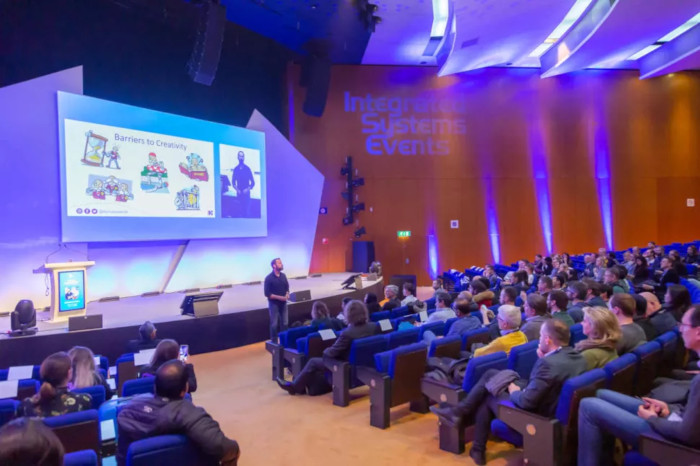
AVIXA’s Higher Education AV Conference shared case studies and perspectives from global delegates on how to use AV to enhance learning outcomes. From connected campus digital signage to wireless collaboration suites, it was clear that end users are demanding more functionality and customization from classroom and campus AV solutions—and manufacturers aim to deliver.
ISE hosted a SCHOMS alliance meeting for senior managers working within UK and Republic of Ireland higher educational institutions. SCHOMS members help evaluate emerging technologies, like new AV/IT debuts at ISE, and use those insights to collaborate on the pedagogic direction of teaching spaces. Manufacturers like QSC and Kramer partnered with SCHOMS to showcase new software-based AV/IT ecosystems.
Here are a few key higher education AV trends and product debuts that grabbed attention at ISE 2020.
Tech & Learning Newsletter
Tools and ideas to transform education. Sign up below.
Next-Level Interactivity & IT-Friendly Features
There’s no shortage of screens in college classrooms. From student smartphones to projection screens to digital whiteboards, the average college has a surfeit of displays. The challenge now is to innovate the display category in support of pedagogic excellence. The pressure has never been greater for educational institutions to show exactly how teaching methods and investments in digital tools can help meet learning outcomes.
To that end, Samsung Electronics America has introduced the updated Flip 2 at ISE with integrated Cisco Webex functionality. The latest version brings together the Webex Teams and Webex Roomkit Mini solution within the Samsung Flip 2 display for real-time collaboration for remote users, offering instant two-way collaborative whiteboarding,
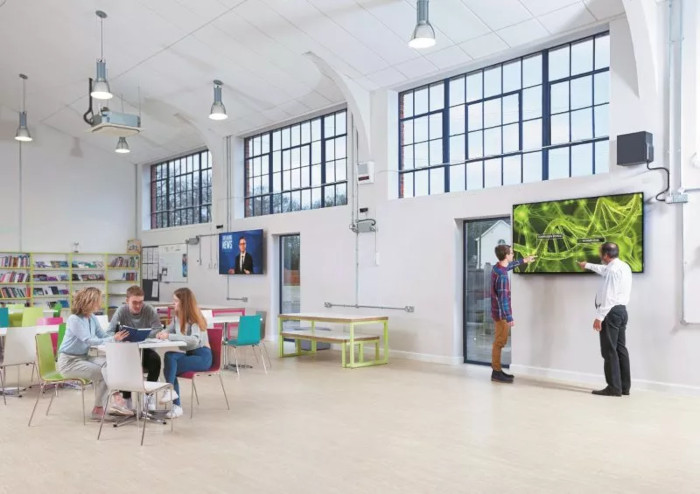
Philips Professional Display Solutions demonstrated its new T-Line range of interactive touch displays for education. Helping students seamlessly interact during lessons, whether in the classroom or remotely, the T-Line is available in 65-, 75- and 86-inch model variants. Each display features multi-touch interaction, and displays can also connect with a keyboard and mouse. Supporting all major operating systems, including ChromeOS, macOS, Windows, and iOS, up to 64 students can contribute to lessons without leaving their seat.
Promethean showcased its new ActivPanel Titanium 70- 4K, 75- 4K, and 86- 4K models allowing teachers and students to collaborate with up to 20 simultaneous touchpoints. The company’s “intelligent palm rejection technology” recognizes when a user is writing verses just touching the screen or resting hands near the device. The product’s wireless mirroring, Wi-Fi, and Bluetooth connectivity features are ideal for BYOD, sensor reading, and IoT environments. Remote management make pushing software and firmware updates quick and easy for the in-house tech team.
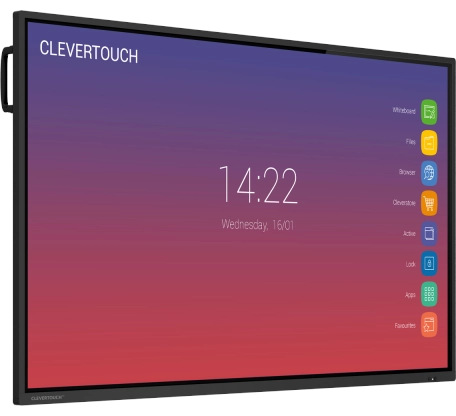
“Designed by teachers,” Clevertouch says its new IMPACT Plus is more an interactive touchscreen—it was created to deliver a highly collaborative experience with native support for apps like Google Classroom.
Smarter Projection
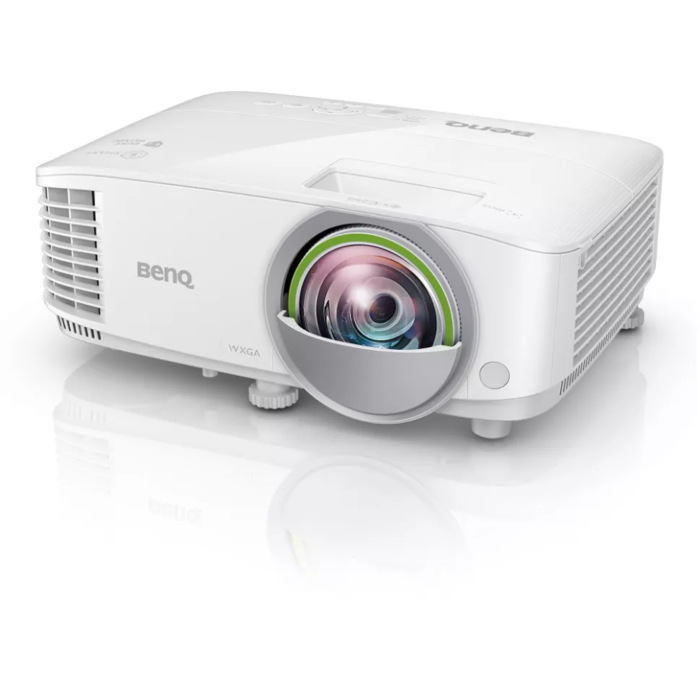
BenQ utilized the ISE stage to launch its EW800ST, a projector designed specifically for classrooms, with native cloud account integration, screen-mirroring capabilities, app functionality, and internet and wireless connectivity. The goal with this short-throw model is to enhance diversified teaching and blended learning so teachers and students can break away from “traditional” lectures modes and access more types of course content in more places in a classroom. For active learning environments, this new BenQ model is worth considering.
Data, Dashboards, Cloud
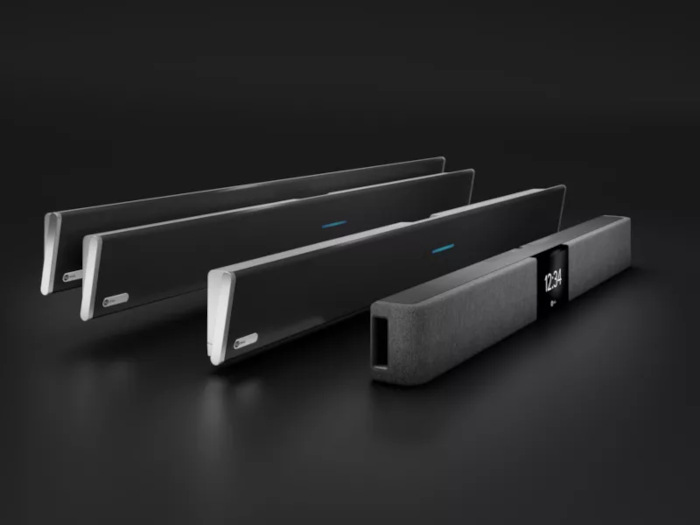
From installed videowalls to networked AV endpoints, higher educational stakeholders are looking for connected AV/IT ecosystems in which all technology assets can be remotely monitored and managed. This is influencing solutions-oriented AV product development by the likes of QSC, Crestron, Extron, Kramer, Atlona, Barco, and Aurora, just to name a few. Take Nureva, for example, who debuted the Nureva Console at ISE which offers customers scalability of their audio systems with remote management of all Nureva systems from one dashboard. This cloud-based platform will be available in March at no additional cost to customers. Not only will the single dashboard provide a streamlined way to view connected systems, it will provide metrics and usage data on those endpoints. This is just one example of how the AV/IT convergence paradigm is shaping product development—most users want AV that can be discovered, managed, and updated like other IT assets in a venue.
IP-Based Transport
MuxLab showed its 4K@60Hz HDMI over IP H.264/H.265 power-over-ethernet (PoE) transmitter at ISE, touting its robust transport method. Because of the low bandwidth required to achieve a high-quality image, and with 200ms latency, MuxLab believes “this solution is ideal for most applications that stream content over a LAN, particularly in classrooms and digital signage applications.” Classroom projectors are likely to be a good application for this new transmitter.
Personalized Yet Flexible Audio
Listen Technologies shared a new Wi-Fi streaming solution at ISE, Listen EVERYWHERE, designed for personal and assistive listening. The system can be integrated into an existing wireless network, and it allows users to stream audio from TVs and other audio sources directly to smartphones or tablets via the Listen EVERYWHERE app. The ListenTALK suite, also on display at ISE, includes various systems, receivers, and accessories for wireless listening, collaboration, and portable assistive listening.
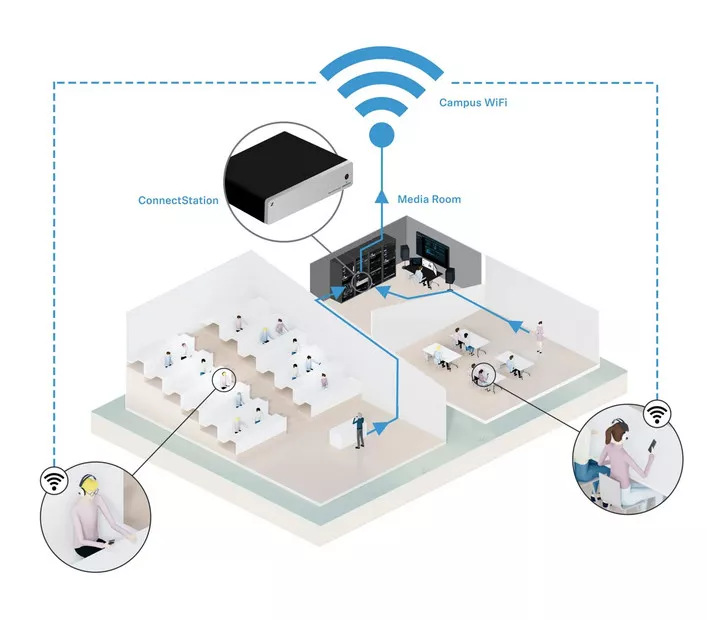
Sennheiser took a similar personalized approach with its new generation of the MobileConnect streaming solution. This audio platform offers students an individual assistive listening capability via their own smartphone. The system gives operators creative flexibility for implementation, with the ability to manage numerous devices from a central location.
“MobileConnect provides assistive listening in an extremely simple way via Wi-Fi and the student’s personal smartphone,” said Jakub Kolacz, manager, Product and Commercialization at Sennheiser Streaming Technologies. “Students do not have to borrow a special receiver or sit in a designated area but can choose their seat wherever they like in the lecture hall. That is real inclusion.”
The Nureva HDL200 also made its debut at ISE. Engineered for smaller spaces, the system has a built-in LCD to provide participants with helpful information, such as call status, room booking, etc. While a good fit for the enterprise market, there are various ways the HDL200 can complement the collaboration spaces within the university sector. Nureva also showcased its Microphone Mist technology which fills a space with thousands of virtual microphones to provide full-room pickup from a central endpoint. This unique approach has proved useful for blended learning and distance learning applications in higher education.
Native Support & Wireless Collaboration
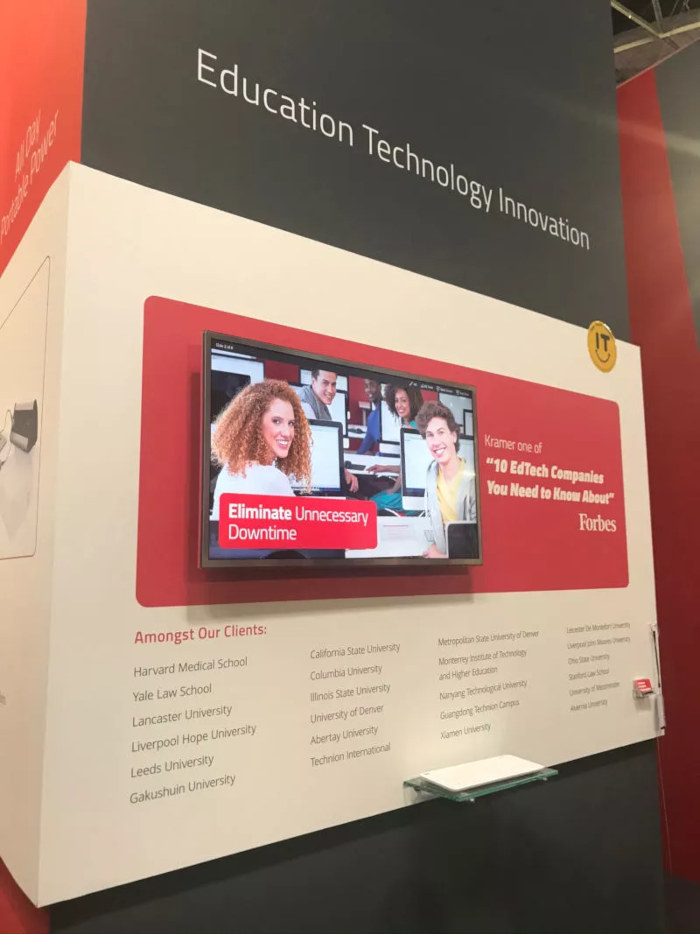
Bridging the gap between IT and AV, and delivering solutions for BYOD, are two key goals for Kramer. At ISE, the company launched the Kramer VIA GO² and Kramer VIA Campus² wireless sharing options designed for educational and meeting environments. Built on the premise of “multiple functionality on a single device,” Kramer’s VIA GO² is a compact wireless sharing solution with a 4K HDMI output, 1024-bit encryption, 60-hertz video streaming, and native AirPlay, Miracast, and Chromebook.
Kramer’s VIA Campus² can show up to six student/presenter screens on a single main display simultaneously and 12 on a dual-display setup. It also features native iOS mirroring for MacBook, iPad and iPhone, as well as mirroring for Chromebook and Android, while supporting Miracast in Peer-to-Peer and Infrastructure modes.
Barco’s Clickshare, WePresent, Mersive, and Crestron’s AirMedia 2.0 were just a few of the other notable vendors and wireless collaboration systems at ISE.
Value Proposition
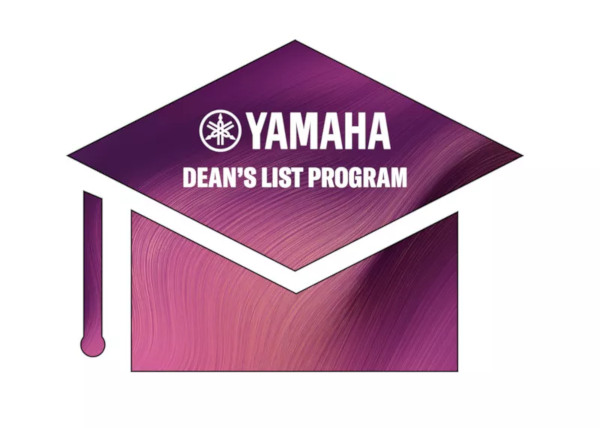
The value equation continues to evolve around hardware and “traditional” AV equipment. ProAV vendors are looking for new ways to offer value and build customer loyalty. Yamaha Unified Communications’ Dean's List Program addresses that need, letting U.S.- and Canada-based colleges, universities, K-12 schools, and other qualified institutions purchase Yamaha equipment at reduced pricing. Yamaha UC shared that news and demonstrated its YVC-330 portable USB and Bluetooth conference phone, the CS-700 video sound bar range, and various UCC products at ISE 2020.
Esports
ISE was buzzing with panel discussions and informal conversations about esports and its serious potential for AV integrators, designers, and consultants. As esports arenas and animation studios grow in popularity across the world, stakeholders are investigating and specifying ultra-high definition displays with required refresh rates, immersive audio, and networking systems to ensure low-latency transport. Total esports market estimates are $1 billion industry with viewership expected to grow at a nine percent compound annual growth rate between 2019 and 2023, to 646 million in 2023, per Business Insider Intelligence estimates.
Four-year universities, like Oklahoma City University, and liberal arts colleges are exploring ways to develop esports as majors and minor concentrations, similar to game design, animation, and VR design.
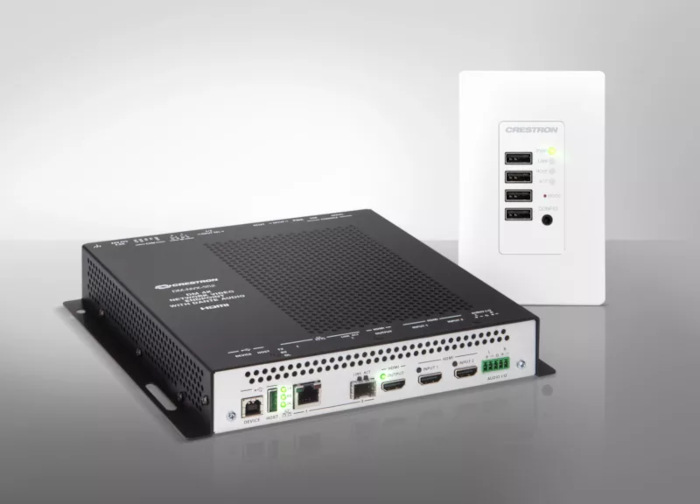
To feed next-gen esports applications across campus endpoints with no visible latency, in-house university tech teams are exploring IP-based distribution systems, like Crestron’s DM NVX AV-over-IP platform. Crestron used the ISE 2020 spotlight to debut the latest enhancements to its DM NVX, including native support for the AES67 audio-over-IP standard and ultra-fast switching. The new functionality will be available for existing DM NVX products via a free firmware upgrade.
Expect to hear much more about these IP-based edtech solutions and broader trends in the coming months.
Margot Douaihy, PhD, is a writer, editor, and educator.
